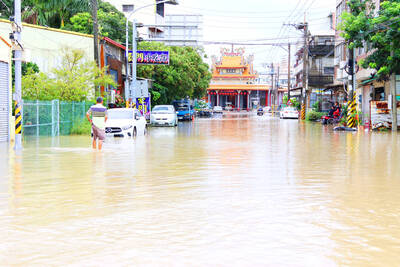Australia’s central bank chief set out an aggressive plan for further rate rises to curb inflation yesterday, warning against a “timid” policy as the economy sees the fastest recovery in the developed world.
Reserve Bank of Australia (RBA) Governor Glenn Stevens, who stunned markets last week with the first hike in an advanced economy since the financial crisis, said interest rates should not stay too low.
“The risks of really serious economic weakness have abated,” he told a business forum in Perth, adding “Australia has had an experience that, even if labeled a recession, was a pretty mild one.”
“That is, clearly, a good outcome in the circumstances. Now that the risks of really serious economic weakness have abated, however, the question arises as to how to configure monetary policy for the recovery,” he said.
Australia sent ripples through international markets earlier this month when it became the first G20 nation to raise interest rates since the onset of the global financial crisis.
Stevens said Australia should learn from its success in slashing rates from 7.25 percent to 3 percent, a five-decade low, before lifting them 25 basis points on Oct. 6.
That surprise decision boosted markets around the world as investors cheered Australia’s vote of confidence that the worst crisis since the Great Depression was ending.
Stevens said that the very low interest rates were based on predictions that the economy would weaken more than it did.
Gradual growth in the economy was likely to continue next year, and the bank board now had to consider the threat of rising inflation, he said.
“If we were prepared to cut rates rapidly, to a very low level, in response to a threat but then were too timid to lessen that stimulus in a timely way when the threat had passed, we would have a bias, a very serious bias, in our monetary policy framework,” Stevens said.
Other central banks have not followed Australia in hiking rates, reflecting it had weathered the worst global downturn in decades better than other developed countries.
Stevens said Australia had headed off the worst effects of the recession with the help of low interest rates, the government’s massive stimulus spending, and economic recovery in China.
He said this did not mean the economy was currently “too strong,” only that the “downside risks to which the board was responding earlier have not materialized.”
Meanwhile, Japan’s central bank upgraded its assessment of the economy yesterday for a second month as it shows more signs of a recovery from the deepest postwar recession.
“Japan’s economy has started to pick up,” the Bank of Japan said in its monthly report in Tokyo, repeating language used in a policy statement released on Wednesday.
Bank of Japan Governor Masaaki Shirakawa said on Wednesday that signs of a rebound are spreading while economic conditions remain severe.
The central bank raised its evaluation of business investment, saying the pace of deterioration is moderating, the report showed.

WAITING GAME: The US has so far only offered a ‘best rate tariff,’ which officials assume is about 15 percent, the same as Japan, a person familiar with the matter said Taiwan and the US have completed “technical consultations” regarding tariffs and a finalized rate is expected to be released soon, Executive Yuan spokeswoman Michelle Lee (李慧芝) told a news conference yesterday, as a 90-day pause on US President Donald Trump’s “reciprocal” tariffs is set to expire today. The two countries have reached a “certain degree of consensus” on issues such as tariffs, nontariff trade barriers, trade facilitation, supply chain resilience and economic security, Lee said. They also discussed opportunities for cooperation, investment and procurement, she said. A joint statement is still being negotiated and would be released once the US government has made

NEW GEAR: On top of the new Tien Kung IV air defense missiles, the military is expected to place orders for a new combat vehicle next year for delivery in 2028 Mass production of Tien Kung IV (Sky Bow IV) missiles is expected to start next year, with plans to order 122 pods, the Ministry of National Defense’s (MND) latest list of regulated military material showed. The document said that the armed forces would obtain 46 pods of the air defense missiles next year and 76 pods the year after that. The Tien Kung IV is designed to intercept cruise missiles and ballistic missiles to an altitude of 70km, compared with the 60km maximum altitude achieved by the Missile Segment Enhancement variant of PAC-3 systems. A defense source said yesterday that the number of

Taiwanese exports to the US are to be subject to a 20 percent tariff starting on Thursday next week, according to an executive order signed by US President Donald Trump yesterday. The 20 percent levy was the same as the tariffs imposed on Vietnam, Sri Lanka and Bangladesh by Trump. It was higher than the tariffs imposed on Japan, South Korea and the EU (15 percent), as well as those on the Philippines (19 percent). A Taiwan official with knowledge of the matter said it is a "phased" tariff rate, and negotiations would continue. "Once negotiations conclude, Taiwan will obtain a better

FLOOD RECOVERY: “Post-Typhoon Danas reconstruction special act” is expected to be approved on Thursday, the premier said, adding the flood control in affected areas would be prioritized About 200cm of rainfall fell in parts of southern Taiwan from Monday last week to 9am yesterday, the Central Weather Administration (CWA) said. Kaohsiung’s Taoyuan District (桃源) saw total rainfall of 2,205mm, while Pingtung County’s Sandimen Township (三地門) had 2,060.5mm and Tainan’s Nanhua District (南化) 1,833mm, according to CWA data. Meanwhile, Alishan (阿里山) in Chiayi County saw 1,688mm of accumulated rain and Yunlin County’s Caoling (草嶺) had 1,025mm. The Pingtung County Government said that 831 local residents have been pre-emptively evacuated from mountainous areas. A total of 576 are staying with relatives in low-lying areas, while the other 255 are in shelters. CWA forecaster